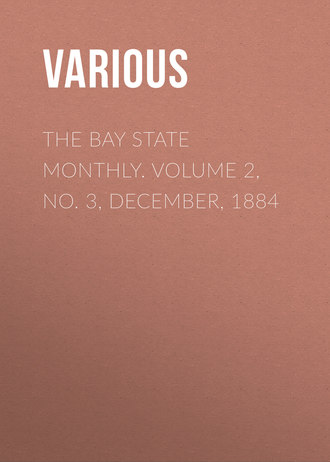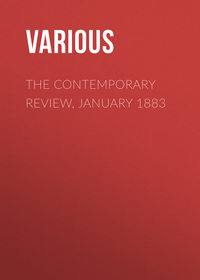 полная версия
полная версияThe Bay State Monthly. Volume 2, No. 3, December, 1884
"Aux armes, citoyens / Formes vos bataillons!"
The Lafayette, in New York, is perhaps a mediocre statue, but even so, it is better than most of our statues. A Frenchman has said of it that the figure "resembles rather a young tenor hurling out his C sharp, than a hero offering his heart and sword to liberty." It represents our ancient ally extending his left hand in a gesture of greeting, while his right hand, which holds his sword, is pressed against his breast in a somewhat theatrical movement. It will be inferred that the general criticism to be made upon Mr. Bartholdi's statues is that they are violent and want repose. The Vercingetorix, the Rouget de l'Isle, the Lafayette, all have this exaggerated stress of action. They have counterbalancing features of merit, no doubt, but none of so transcendent weight that we can afford to overlook this grave defect.
Coming now to the main question, which it is the design of this paper to discuss, the inquiry arises: What of the colossal statue of Liberty as a work of art? For, no matter how noble the motive may be, or how generous the givers, it must after all be subjected to this test. If it is not a work of art, the larger it is, the more offensive it must be. There are not wanting critics who maintain that colossal figures cannot be works of art; they claim that such representations of the human form are unnatural and monstrous, and it is true that they are able to point out some "terrible examples" of modern failures, such, for instance, as the "Bavaria" statue at Munich. But these writers appear to forget that the "Minerva" of the Parthenon and the Olympian Jupiter were the works of the greatest sculptor of ancient times, and that no less a man than Michael Angelo was the author of the "David" and "Moses." It is therefore apparent that those who deny the legitimacy of colossal sculptures in toto go too far; but it is quite true that colossal works have their own laws and are subject to peculiar conditions. Mr. Lesbazeilles7 says that "colossal statuary is in its proper place when it expresses power, majesty, the qualities that inspire respect and fear; but it would be out of place if it sought to please us by the expression of grace.... Its function is to set forth the sublime and the grandiose." The colossi found among the ruins of Egyptian Temples and Palaces cannot be seen without emotion, for if many of them are admirable only because of their great size, still no observer can avoid a feeling of astonishment on account of the vast energy, courage and industry of the men of old who could vanquish such gigantic difficulties. At the same time it will not do to assume that the Egyptian stone cutters were not artists. The great Sphinx of Giseh, huge as it is, is far from being a primitive and vulgar creation. "The portions of the head which have been preserved," says Mr. Charles Blanc, "the brow, the eyebrows, the corners of the eyes, the passage from the temples to the cheek-bones, and from the cheek-bones to the cheek, the remains of the mouth and chin,—all this testifies to an extraordinary fineness of chiselling. The entire face has a solemn serenity and a sovereign goodness." Leaving aside all consideration of the artistic merits of other Egyptian colossi,—those at Memphis, Thebes, Karnac and Luxor, with the twin marvels of Amenophis-Memnon—we turn to the most famous colossus of antiquity, that at Rhodes, only to find that we have even less evidence on which to base an opinion as to its quality than is available in the case of the numerous primitive works of Egypt and of India. We know its approximate dimensions, the material of which it was made, and that it was overthrown by an earthquake, but there seems to be reason to doubt its traditional attitude, and nothing is known as to what it amounted to as a work of art, though it may be presumed that, being the creation of a Greek, it had the merits of its classic age and school. Of the masterpieces of Phidias it may be said that they were designed for the interiors of Temples and were adopted with consummate art to the places they occupied; they have been reconstructed for us from authentic descriptions, and we are enabled to judge concerning that majestic and ponderous beauty which made them the fit presentments of the greatest pagan deities. I need say nothing of the immortal statues by Michael Angelo, and will therefore hasten to consider the modern outdoor colossi which now exist in Europe—the St. Charles Borromeo at Arona, Italy, the Bavaria at Munich, the Arminius in Westphalia, Our Lady of Puy in France. The St. Charles Borromeo, near the shore of Lake Maggiore, dates from 1697, and is the work of a sculptor known as Il Cerano. Its height is 76 feet, or with its pedestal, 114 feet. The arm is over 29 feet long, the nose 33 inches, and the forefinger 6 feet 4 inches. The statue is entirely of hammered copper plates riveted together, supported by means of clamps and bands of iron on an interior mass of masonry. The effect of the work is far from being artistic. It is in a retired spot on a hill, a mile or two from the little village of Arona. The Bavaria, near Munich, erected in 1850, is 51 feet high, on a pedestal about 26 feet high, and is the work of Schwanthaler. It is of bronze and weighs about 78 tons. The location of this monstrous lump of metal directly in front of a building emphasizes its total want of sculptural merit, and makes it a doubly lamentable example of bad taste and bombast. The Arminius colossal, on a height near Detmold in Westphalia, was erected in 1875, is 65 feet high, and weighs 18 tons. The name of the sculptor is not given by any of the authorities consulted, which is perhaps just as well. This statue rests on "a dome-like summit of a monumental structure," and brandishes a sword 24 feet long in one hand. The Virgin of Puy is by Bonassieux, was set up in 1860, is 52 feet high, weighs 110 tons, and stands on a cliff some 400 feet above the town. It is, like the Bavaria, of bronze, cast in sections, and made from cannons taken in warfare. The Virgin's head is surmounted by a crown of stars, and she carries the infant Christ on her left arm. The location of this statue is felicitous, but it has no intrinsic value as an art work. It will be seen, then, that these outdoor colossi of to-day do not afford us much encouragement to believe that Mr. Bartholdi will be able to surmount the difficulties which have vanquished one sculptor after another in their endeavors to perform similar prodigies. Sculpture is perhaps the most difficult of the arts of design. There is an antique statue in the Louvre which displays such wonderful anatomical knowledge, that Reynolds is said to have remarked, "to learn that alone might consume the labor of a whole life." And it is an undeniable fact that enlarging the scale of a statue adds in more than a corresponding degree to the difficulties of the undertaking. The colossi of the ancients were to a great extent designed for either the interiors or the exteriors of religious temples, where they were artfully adapted to be seen in connection with architectural effects. Concerning the sole prominent exception to this rule, the statue of Apollo at Rhodes, we have such scant information that even its position is a subject of dispute. It has been pointed out how the four modern outdoor colossi of Europe each and all fail to attain the requirements of a work of art. All our inquiries, it appears then, lead to the conclusion that Mr. Bartholdi has many chances against him, so far as we are able to learn from an examination of the precedents, and in view of these facts it would be a matter for surprise if the "Liberty" statue should prove to possess any title to the name of a work of art. We reserve a final decision, however, as to this most important phase of the affair, until the statue is in place.
The idea that great size in statues is necessarily vulgar, does not seem admissible. It would be quite as just to condemn the paintings on a colossal scale in which Tintoretto and Veronese so nobly manifested their exceptional powers. The size of a work of art per se is an indifferent matter. Mere bigness or mere littleness decides nothing. But a colossal work has its conditions of being: it must conform to certain laws. It must be executed in a large style; it must represent a grand idea; it must possess dignity and strength; it must convey the idea of power and majesty; it must be located in a place where its surroundings shall augment instead of detracting from its aspect of grandeur; it must be magnificent, for if not it will be ridiculous. The engravings of Mr. Bartholdi's statue represent a woman clad in a peplum and tunic which fall in ample folds from waist and shoulder to her feet. The left foot, a trifle advanced supports the main weight of the body. The right arm is uplifted in a vigorous movement and holds aloft a blazing torch. The left hand grasps a tablet on which the date of the Declaration of Independence appears; this is held rather close to the body and at a slight angle from it. The head is that of a handsome, proud and brave woman. It is crowned by a diadem. The arrangement of the draperies is, if one may judge from the pictures, a feature of especial excellence in the design. There is merit in the disposition of the peplum or that portion of the draperies flung back over the left shoulder, the folds of which hang obliquely (from the left shoulder to the right side of the waist and thence downward almost to the right knee,) thus breaking up the monotony of the perpendicular lines formed by the folds of the tunic beneath. The movement of the uplifted right arm is characterized by a certain elan which, however, does not suggest violence; the carriage of the head is dignified, and so far as one may judge from a variety of prints, the face is fine in its proportions and expression. I do not find the movement of the uplifted arm violent, and, on the whole, am inclined to believe the composition a very good one in its main features. There will be an undeniable heaviness in the great masses of drapery, especially as seen from behind, but the illusion as to the size of the figure created by its elevation on a pedestal and foundation nearly twice as high as itself may do much towards obviating this objection. The background of the figure will be the
… Spacious firmament on high,With all the blue etherial sky,And spangled heavens …The island is far enough removed from the city so that no direct comparisons can be made between the statue and any buildings. Seen from the deck of a steamer at a distance say of a quarter of a mile, the horizon, formed by the roofs, towers, spires and chimneys of three cities, will not appear higher than the lower half of the pedestal. In other words the statue will neither be dwarfed nor magnified by the contiguity of any discordant objects. It will stand alone. The abstract idea, as has been said, is noble. The plan of utilizing the statue as a lighthouse at night does not detract from its worth in this respect; it may be said to even emphasize the allegorial sense of the work. "Liberty enlightening the world," lights the way of the sailor in the crowded harbor of the second commercial city of the world. The very magnitude of the work typifies, after a manner, the vast extent of our country, and the audacity of the scheme is not inappropriate in the place where it is to stand. It may be, indeed, that when the statue is set up, we shall find it awkward and offensive, as some critics have already prophecied: but that it must be so inevitably does not appear to me to be a logical deduction from the information we have at hand as to the artist and his plans. It is freely admitted that no modern work of this nature has been successful, but that does not prove that this must absolutely be a failure. The project ought not to be condemned in advance because of the great difficulties surrounding it, its unequalled scope and its novelty. Mr. Bartholdi is above all ingenious, bold, and fertile in resources; it would be a great pity not to have him allowed every opportunity to carry out a design in which, as we have seen, there are so many elements of interest and even of grandeur. It has been said that "there does not exist on French soil such a bombastic work as this will be." Very well; admitting for the sake of argument that it will be bombastic, shall we reject and condemn a colossal statue before having seen it, because there is nothing like it in France? And is it true that it will be bomastic? That is by no means demonstrated. On the contrary an impartial examination of the design would show that the work has been seriously conceived and thought out; that it does not lack dignity; that it is intended to be full of spirit and significance. It would be the part of wisdom at least to avoid dogmatism in an advance judgment as to its worth as a work of art, and to wait awhile before pronouncing a final verdict.
Hazlitt tells of a conceited English painter who went to Rome, and when he got into the Sistine Chapel, turning to his companion, said, "Egad, George, we're bit!" Our own tendency is, because of our ignorance, to be sceptical and suspicious as to foreign works of art, especially of a kind that are novel and daring. No one is so hard to please as a simpleton. We are so afraid of being taken in, that we are reluctant to commit ourselves in favor of any new thing until we have heard from headquarters; but it appears to be considered a sign of knowledge to vituperate pictures and statues which do not conform to some undefinable ideal standard of our own invention. There is, of course, a class of indulgent critics who are pernicious enough in their way; but the savage and destructive criticism of which I speak is quite as ignorant and far more harmful. It assumes an air of authority based on a superficial knowledge of art, and beguiles the public into a belief in its infallibility by means of a smooth style and an occasional epigram the smartness of which may and often does conceal a rank injustice. The expression of a hope that the result of Mr. Bartholdi's labors "will be something better than another gigantic asparagus stalk added to those that already give so comical a look to our sky-line," is truly an encouraging and generous utterance at this particular stage of the enterprise, and equals in moderation the courteous remark that the statue "could not fail to be ridiculous in the expanse of New York Bay."8 It is not necessary to touch upon the question of courtesy at all, but it is possible that one of our critics may live to regret his vegetable metaphor, and the other to revise his prematurely positive censure. There is a sketch in charcoal which represents the Bartholdi colossus as the artist has seen it in his mind's eye, standing high above the waters of the beautiful harbor at twilight, when the lights are just beginning to twinkle in the distant cities and when darkness is softly stealing over the service of the busy earth and sea. The mystery of evening enwraps the huge form of the statue, which looms vaster than by day, and takes on an aspect of strange majesty, augmented by the background of hurrying clouds which fill the upper portion of the sky. So seen, the immense Liberty appears what the sculptor wishes and intends it to be, what we Americans sincerely hope it may be,—a fitting memorial of an inspiring episode in history, and a great work of modern art.
ELIZABETH. 9
A ROMANCE OF COLONIAL DAYS
CHAPTER III.
IDLESSE
"Don't move your head, Elizabeth, keep it in that position a little longer," said Katie Archdale, as she and her friend sat together the morning after the sail. "I wish an artist were here to paint you so; you've no idea how striking you are."
"No, I have not," laughed the other, forgetting to keep still as she spoke, and turning the face that had been toward the window full upon her companion. The scene that Elizabeth's eyes had been dwelling upon was worthy of admiration; her enthusiasm had not escaped her in any word, but her eyes were enraptured with it, and her whole face, warmed with faint reflection of the inward glow, was beautiful with youth, and thought, and feeling.
"Now you've spoilt it," cried Katie, "now you are merely a nice-looking young lady; you were beautiful before, perfectly beautiful, like a picture that one can look at, and look at, and go away filled with, and come back to, and never tire of. The people that see you so worship you, but then, nobody has a chance to do it. You just sit and don't say much except once in a while when you wake up, then you are brilliant, but never tender, as you know how to be. You give people an impression that you are hard. Sometimes I should like to shake you."
Elizabeth laughed.
"That's the way you worship me," she answered. "I suspected it was a strange kind of adoration, largely made up of snubbing."
"It's not snubbing," retorted Katie, "it is trying to rouse you to what you you might be. But I am wasting my breath; you don't believe a word I say."
"I should like to believe it," returned the girl, smiling a little sadly. "But even if I did believe every word of it, it would seem to me a great deal nicer to be like you, beautiful all the time, and one whom everybody loves. But there's one thing to be said, if it were I who were beautiful, I could'nt have the pleasure I do in looking at you, and perhaps, after all, I shouldn't get any more enjoyment out of it."
"Oh, yes, you would," retorted the other, then bit her lips angrily at her inadvertence. A shrewd smile flitted over Elizabeth's face, but she made no comment, and Katie went on hurriedly to ask, "What shall we do to amuse ourselves to-day, Betsey?" Another slight movement of the hearer's lips responded. This name was Katie's special term of endearment, and never used except when they were alone; no one else ever called her by it.
"I don't know," she said. "Let us sit here as we are doing now. Move your chair nearer the window and look down on the river. See the blue-black shadows on it. And look at the forests, how they stretch away with a few clearings here and there. A city behind us, to be sure, a little city, but before us the forests, and the Indians. I wonder what it all means for us."
"The axe for one, the gun for the other," retorted Katie with a hardness which belief in the savageness and treachery of the red man had instilled into the age. "The forests mean fortune to some of us," she added.
"Yes," answered Elizabeth slowly, finding an unsatisfactory element in her companion's summary.
"Do you mean that we shall have to shoot down a whole race? That is dreadful," she added after a pause.
"You and I have nothing to do with all that," returned Katie.
Elizabeth waited in despair of putting the case as she felt it.
"I was thinking," she said at last, "that if we have a whole land of forests to cut down and of cities to build up, somehow, everything will be different here from the Old England. I often wonder what it is to be in this New World. It must be unlike the Old," she repeated.
"I don't wonder," returned Katie, "and that's just what you shouldn't do. Wonder what you're going to wear to-morrow when we dine at Aunt Faith's, or whether Master Harwin will call this morning, or Master Waldo, or wonder about something sensible."
"Which means, 'or if it's to be Master Archdale,'" retorted Elizabeth, smiling into the laughing eyes fixed upon her face, and making them fall at the keenness of her glance, while a brighter rose than Katie cared to show tinted the creamy skin and made her bend a moment to arrange the rosette of her slipper. The movement showed her hair in all its perfection, for at this early hour it had not been tortured into elaborateness, but as she sat in her bedroom talking with her guest, was loosely coiled to be out of the way, and thus drawn back in its wavy abundance showed now burnished, and now a darker brown, as the sunlight or the shadow fell upon it.
"He's not always sensible," she answered, lifting her head again with a half defiant gesture, and smiling. Katie's smile was irresistible, it won her admirers by the score, not altogether because it gave a glimpse of beautiful teeth, or because her mouth was at its perfection then, but that it was an expression of childlike abandonment to the spirit of the moment, which charmed the gay because they sympathized with it and the serious because it was a mood of mind into which they would be glad to enter. "Stephen has not been quite himself lately, rather stupid," and she looked as if she were not unsuspicious of the reason.
"Too many of us admirers, he thinks?" laughed Elizabeth. "For he is bright enough when he takes the trouble to speak, but generally he doesn't seem to consider any one of sufficient importance to amuse."
"That is not so," cried Katie, "you are mistaken. But you don't know Stephen very well," she added. "What a pity that you are not living here, then you would, and then we should have known each other all our lives, instead of only since we went to school together. What good times we had at Madam Flamingo's. There you sit, now, and look as meekly reproving as if you had'nt invented that name for her yourself. It was so good, it has stood by her ever since."
"Did I? I had forgotten it."
"Perhaps, at least, you remember the red shawl that got her the nickname? It was really something nice,—the shawl, I mean, but the old dame was so ridiculously proud of it and so perpetually flaunting it, she must have thought it very becoming. We girls were tired of the sight of it. And one day, when you were provoked with her about something and left her and came into the schoolroom after hours, you walked up to a knot of us, and with your air of scorn said something about Madam Flamingo. Didn't it spread like wildfire? Our set will call that venerable dame 'Flamingo' to the end of her days."
"I suppose we shall, but I had no recollection that it was I who gave her the name."
"Yes, you gave it to her," repeated Katie. "You may be very sure I should not have forgotten it if I had been so clever. Those were happy days for all their petty tribulations," she added after a pause.
Elizabeth looked at her sitting there meditative.
"I should think these were happy days for you, Katie. What more can you want than you have now?"
"Oh, the roc's eggs, I suppose," answered the girl. "No, seriously, I am pretty likely to get what I want most. I am happy enough, only not absolutely happy quite yet."
"Why not?"
"Our good minister would say it was not intended for mortals."
"If I felt like being quite content I should not give it up because somebody else said it was too much for me."
"Oh, well," said Katie, laughing, "it has nothing to do with our good Parson Shurtleff, anyway."
"I thought not. What, then?"
The other did not answer, but sat looking out of the window with eyes that were not studying the landscape. Whether her little troubles dissolved into the cloudless sky, like mist too thin to take shape, or whether she preferred to keep her perplexities to herself is uncertain, but when she spoke it was about another reminiscence of school days.
"Do you remember that morning Stephen came to see me?" she began. "Madam thought at first that Master Archdale must be my father, and she gave a most gracious assent to my request to go to walk with him. I was dying of fun all the time, I could scarcely keep my face straight; then, when she caught a glimpse of him as we were going out of the hall, she said in a dubious tone, 'Your brother, I presume, Mistress Archdale?' But I never heard a word. I was near the street door and I put myself the other side of it without much delay. So did Stephen. And we went off laughing. He said I was a wicked little cousin, and he spelled it 'cozen;' but he didn't seem to mind my wickedness at all." There was a pause, during which Katie looked at her smiling friend, and her own face dimpled bewitchingly. "This is exactly what you would have done, Elizabeth," she said. "You would have heard that tentative remark of Madam's, of course you would, and you would have stood still in the hall and explained that Stephen was your cousin, instead of your brother, and have lost your walk beyond a doubt, you know the Flamingo. Now, I was just as good as you would have been, only, I was wiser. I, too, told Madam that he was my cousin, but I waited until I came home to do it. The poor old lady could not help herself then; it was impossible to take back my fun, and she could not punish me, because she had given me permission to go, nor could she affirm that I heard her remark, for it was made in an undertone. There was nothing left for her but to wrap her illustrious shawl about her and look dignified." "Do you think Master Harwin will come to-day?" Katie asked a few moments later, "and Master Waldo? I hope they will all three be here together; it will be fun, they can entertain each other, they are so fond of one another."











